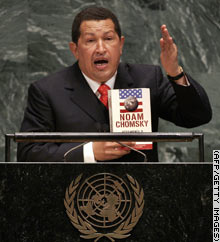'Nothing stops the revolution'
On Jan. 8, Venezuelan president Hugo Chávez sent tremors through the international capitalist market when he announced a new wave of nationalizations. These nationalizations would eliminate foreign control over the country’s largest telecommunications and electricity companies.
 Venezuelan lawmakers, shouting ‘Long live socialism,’ gave President Chávez the go-ahead Jan. 31 to carry out revolutionary measures by decree. |
The day of the announcement, the Caracas Stock Exchange dropped 19 percent, as stockholders rapidly sold their shares in the soon-to-be nationalized industries. This widespread alarm reduced to mere caution when Chávez announced that owners of the nationalized companies would be compensated for their loss.
The market accordingly rebounded, but the fear of widespread state expropriations—reminiscent of the Cuban Revolution—is now imprinted on the collective psyche of foreign investors who still hold out hope for sucking profits from Venezuela’s natural wealth.
They have quite a bit to be worried about. Chávez already proclaimed the trajectory of the revolution when he said, "Dec. 3, 2006"—the day of his landslide re-election—"will remain in history painted red." He proclaimed the next phase of the revolution to be the "National Simon Bolivar Project of 2007-2021," in which "Bolivarian socialism" will decisively be built.
The nationalizations will not stop with the electricity and telecommunications. On Jan. 8, Chávez stated, "All of that which was privatized, let it be nationalized." He specifically identified for state control strategic sectors such as hydrocarbons.
In another important move, Chávez announced that the state would increase its control over the country’s central bank. While the world’s largest financial firms whined that the bank must remain "independent"—actually, dependent only on the biggest imperialist banks—Chávez countered that it would remain "autonomous within the purview of the state."
The question of who owns and controls the means of production is a key question for socialists. The public ownership of the banks and means of production is a cornerstone of a socialist economy, because it deprives the exploiting capitalist class of its single greatest source of power—its ownership of wealth. It opens the possibility for the immense value created by the labor of the working class to be organized and distributed according to people’s needs.
When the major Venezuelan corporations coordinated a nationwide oil lockout in 2002-2003, in order to break the back of the Bolivarian movement, the economy reeled and spent much of the rest of the year in recovery. The movement regrouped stronger than ever, but the damage reflected an unmistakable truth: Key industries and sectors of the Venezuelan economy are still in private hands. They are an umbilical cord linked directly to U.S. imperialism, the main enemy of the Bolivarian revolution.
Of course, capitalist governments also nationalize private industries on occasion. In fact, the Venezuelan government nationalized the oil industry in 1975-76. However, the nationalization was on a capitalist basis, with the profits still flowing to national and foreign investors—at a time when 80 percent of the people lived in poverty. Throughout the 1980s and 1990s, the royalty payments were highly favorable to foreign and national corporations, and the industry was on the verge of being totally privatized.
With Chávez’s first presidential term in 1999, the new Bolivarian Constitution mandated that Venezuela’s oil is permanently prohibited from being privatized. In recent years, the Chávez government has obligated oil investors to pay higher rates of royalties to the state.
The real question is not whether the economy is in state hands or private hands, but what class interests the state represents. That question is being posed more sharply with every passing day in Venezuela.
Chávez and his allies in government are revolutionaries who have created a dual-power situation with parallel institutions like health care, education and energy to challenge and replace the still-existing capitalist superstructure, and directly meet the needs of the people.
The question of state power still remains. Chávez’s Jan. 8 declaration of accelerated moves towards socialist transformation is encouraging news.
The enabling law
The bold declarations on the economic front need to be put in the context of decisive action in the political arena. The
 |
Such enabling laws are nothing new. They are a holdover from the pre-Bolivarian Constitution. Chávez’s predecessors exercised the same authority. Every law Chávez issues is still subject to reversal by popular referendum.
Yet these laws have unleashed howls of criticism from the imperialists and their Venezuelan supporters. They portray them as signs of authoritarianism—a hollow charge by the same forces that cheered on the coup attempt against Chávez in 2002 and welcome the increasingly centralized powers of the Bush administration’s executive branch.
What these pro-imperialist critics fear is what Chávez will do with these new powers. They fear that he will accelerate the process of nationalization, that he will begin to undermine the rights of private property altogether, and, above all, that he will call the masses into a decisive battle against the oil moguls, rich landowners and government careerists and bureaucrats that have at every step tried to blunt and block the anti-capitalist initiatives of the Bolivarian movement.
The United Socialist Party
These measures from above will be strengthened by a new socialist party—the United Socialist Party of Venezuela—which is to be built "from below," drawing on the people’s already existing community councils and social "missions."
The mobilization of the Venezuelan masses has been an indispensable feature of the Bolivarian revolution. It was the great force of the people in the streets that won Chávez two presidential elections, and defended their gains in the streets by defeating the 2002 coup attempt and the well-financed 2004 anti-Chávez referendum. The mass demonstrations in support of the Bolivarian movement—in which red clothing, flags and banners fill the streets of Caracas—have punctuated each one of these victories.
The challenge has been to consolidate these explosive political activities into a united fighting organization, a political party, with a clearly defined plan of action. The Venezuelan movement has been gripped with the same problems facing revolutionaries everywhere: how to turn an activist force into a sustaining force capable of remaking society in the interests of the working class.
To answer this key question, Chávez announced the disbandment of his existing electoral coalition, the Movement for a Fifth Republic (MVR), and the creation of the United Socialist Party of Venezuela.
In his Dec. 15 speech explaining the need for a new party, Chávez noted the example of the Units for the Electoral Battle (UBEs). The UBEs were community-based units organized in 2004 to ensure a pro-Chávez vote in the referendum.
"Afterwards, I asked everyone to maintain the UBEs … but almost everywhere they were lost," Chávez explained. "Let us be sure this does not happen after our great victory of Dec. 3."
Now is the time, Chávez explained, to strive to keep all popular councils and Bolivarian battalions intact. "Let not a single squad dissolve," he declared.
The new party will be "a political instrument at the service not of blocs or groupings but of the people and the Revolution, at the service of socialism."
The party will be built on new foundations. Leaders will be drawn from the existing community organizations and elected on account of their self-sacrifice and commitment. Pointing to the collapse of the Soviet Union—when the powerful Soviet working class remained passive at the decisive political moments—Chávez called on the new party to deeply connect with Venezuela’s oppressed.
Although the specific program of the new party has not been publicized yet, revolutionaries and progressives of the world should greet the United Socialist Party of Venezuela with enthusiasm. It is the most significant attempt to handle the question of political organization—real political independence from the corrupt political parties of the old ruling class—for Venezuela’s toilers.
Accelerating towards socialism
In the seven years since Chávez was first elected, the Bolivarian movement broke the monopoly of political control maintained by the Venezuelan lackeys of Washington. A new constitution created the legal framework for genuine democracy. The Bolivarian Circles represented the seedlings of a new people’s power. The Bolivarian government redistributed the country’s vast natural wealth toward social programs, substantially improving the living standards of Venezuela’s poor.
In this first phase, Chávez’s coalition engaged millions of people just coming into political life and thousands of dedicated community activists. It attracted the country’s best socialists and revolutionaries.
But it also included capitalists and reformists—people with no vision of socialism, who opposed imperialism only from the perspective of improving Venezuelan capitalism. Bureaucrats and careerists also affixed themselves to the Chávez coalition after its 1998 victory as a means for personal gain.
 The Bolivarian revolution still faces the threat of imperialist invasion and U.S.-backed coups. But Chávez has already made clear—even if in not so many words—that the next stage of the Bolivarian movement will be marked by struggle within the Chávez camp. It will be a period of political and class differentiation between those who are prepared to lead the way towards "socialism of the 21st century" and those who see the revolution as a glorified capitalist welfare state.
The Bolivarian revolution still faces the threat of imperialist invasion and U.S.-backed coups. But Chávez has already made clear—even if in not so many words—that the next stage of the Bolivarian movement will be marked by struggle within the Chávez camp. It will be a period of political and class differentiation between those who are prepared to lead the way towards "socialism of the 21st century" and those who see the revolution as a glorified capitalist welfare state.
Battles are looming. As in all battles, timing is of decisive importance. The opposition is reeling from its electoral failures, and the Venezuelan workers are more emboldened than ever. Chávez has judged that the timing is right to launch an offensive.
This offensive can take several forms. On one hand, there may be explicit pro- Chávez, anti-bureaucracy protests, such as the October 2006 demonstration that drew 12,000 people into the streets of Mérida, Venezuela. On the other hand, the government has provided $1.8 billion and an infrastructure for 12,000 community councils, which Chávez openly compares to the Soviets—the councils of workers, peasants and soldiers—of the Russian Revolution. These institutions, if they continue to thrive, serve as a direct counterweight to the remnants of the old capitalist state apparatus.
Chávez’s principal slogan, now adorning billboards and newspaper spreads across the country, is: "Nothing stops the revolution." With a new party under construction, greater executive authority and a powerful working class marching alongside him—now with important, living experience in political struggle—the slogan seems to capture the reality of the Venezuelan revolutionary process.
 Bemba's asylum in the South African embassy is interesting considering what out sources have told us about South Africa's role in the Bemba rebellion. On March 23, 2007, a massive explosion destroyed a Soviet-built warehouse in the Mozambican capital of Maputo. Over 150 people were killed in the explosion and hundreds were wounded. Debris from the explosion was found up to 1 kilometer away from the scene. The explosion was officially blamed on high temperatures in Maputo (93 Fahrenheit -- not unusually hot for the Mozambican capital). However, our sources report that the explosion was set off deliberately by South African mercenaries who had been stealing weapons from the warehouse, including armored-piercing shells, for use in the Bemba coup attempt in Congo and a planned Improvised Explosion Device (IED) assassination attempt against Zimbabwe's embattled President Robert Mugabe. The arms had been warehoused after truce between warring factions in the long Mozambican civil war.
Bemba's asylum in the South African embassy is interesting considering what out sources have told us about South Africa's role in the Bemba rebellion. On March 23, 2007, a massive explosion destroyed a Soviet-built warehouse in the Mozambican capital of Maputo. Over 150 people were killed in the explosion and hundreds were wounded. Debris from the explosion was found up to 1 kilometer away from the scene. The explosion was officially blamed on high temperatures in Maputo (93 Fahrenheit -- not unusually hot for the Mozambican capital). However, our sources report that the explosion was set off deliberately by South African mercenaries who had been stealing weapons from the warehouse, including armored-piercing shells, for use in the Bemba coup attempt in Congo and a planned Improvised Explosion Device (IED) assassination attempt against Zimbabwe's embattled President Robert Mugabe. The arms had been warehoused after truce between warring factions in the long Mozambican civil war. A 2005 federal statute provided that in 2008 “a Federal agency may not accept, for any official purpose, a driver’s license or identification card issued by a State to any person unless the State is meeting the requirements of this section.” “‘Official purpose’ includes but is not limited to accessing Federal facilities, boarding federally regulated commercial aircraft, entering nuclear power plants, and any other purpose that the Secretary [of Homeland Security] may determine.”
A 2005 federal statute provided that in 2008 “a Federal agency may not accept, for any official purpose, a driver’s license or identification card issued by a State to any person unless the State is meeting the requirements of this section.” “‘Official purpose’ includes but is not limited to accessing Federal facilities, boarding federally regulated commercial aircraft, entering nuclear power plants, and any other purpose that the Secretary [of Homeland Security] may determine.”








 On March 1, a Wall Street analyst at
On March 1, a Wall Street analyst at  Securities backed by home mortgages have been traded since the 1970s, but it has been only since 2002 or so that investors, including pension funds, insurance companies, hedge funds and other institutions, have shown such an appetite for them.
Securities backed by home mortgages have been traded since the 1970s, but it has been only since 2002 or so that investors, including pension funds, insurance companies, hedge funds and other institutions, have shown such an appetite for them.